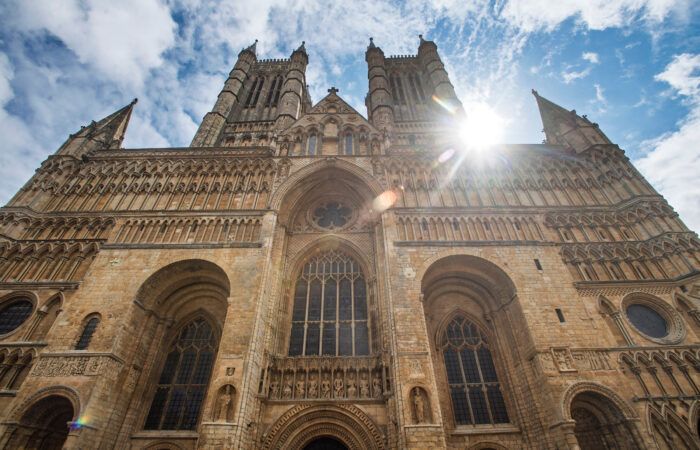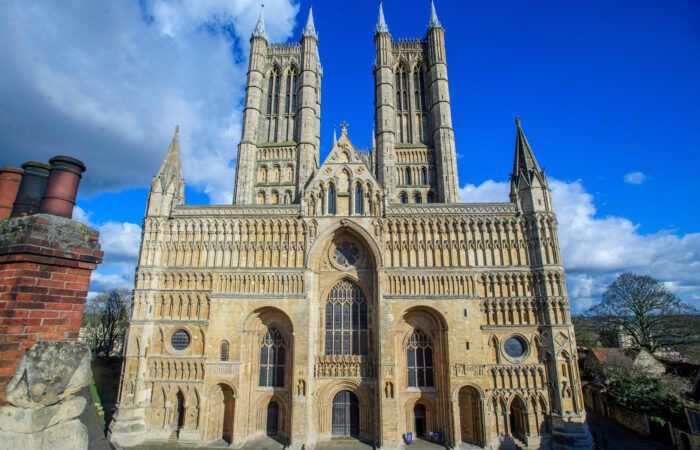A talk by the Canon Chancellor, the Reverend Canon Dr Mark Hocknull, first given in Lincoln Cathedral on Sunday 2 April 2017.
John 19: 25-27
We turn on this Passion Sunday in these Lent meditations to consider Mary the mother of Jesus. A figure who has been hugely significant through the centuries in Christian art and devotion. Many of the art works portraying the crucifixion are drawn from john’s account of the passion and feature Mary the mother of Jesus prominently. I perhaps ought to begin with a health warning or a caveat. My rather low evangelical church background has left me ill equipped to do justice to Mary. The faith I received was woven together from various Bible texts. Perhaps surprisingly, given Mary’s prominence in Christian art and tradition, the Bible from which I learned the faith has little to say about Mary as a person and character. There is a strand of Christian spirituality in which Mary figures prominently. Many sincere and devout Christians, including members of this Cathedral community find this form of spirituality extremely helpful and a significant part of their Christian life and discipleship. We might expect this, after all the Cathedral is dedicated to Mary. We are the Cathedral of the Blessed Virgin Mary of Lincoln, as we are reminded every day in the foundation prayers at evensong. Nevertheless, more often than not, I’m left puzzled by this Marian spirituality. It passes me by completely. So I doubt that I will be able to do Mary justice, and you will have to check any prejudices you find here against your own. You will have to fill in the gaps in her story and perhaps even tell her story differently. A word of warning, along with the confession however. There is a danger of idealizing Mary in a way that becomes oppressive rather than life-giving. We might so emphasize her virginity that only her sexuality becomes important in a way that can be profoundly unhelpful to men and women. Likewise, if we overemphasize Mary as mother or wife, since then it is only her relationship to significant men that seems to matter and the only context in which she seems to be relevant is a domestic one. So there is some merit in focusing our attention on Mary as she is portrayed in the Gospel of John. One the one hand in John, there is no account of the virgin birth. On the other hand, there is good reason to believe that Mary is an important character in John’s narrative, not just in her own right, but as a representative of others. A theme which has run through all of these Lent addresses.
Mary appears only twice in John’s Gospel and both of these appearances are unique to John. She appears first of all at the beginning of Jesus public ministry at the Wedding at Cana, and then again at the foot of the cross at the very end of Jesus’ earthly life. The whole narrative of Jesus’ ministry is set between these two episodes.
On the surface, the wedding at Cana is a rather profane miracle story: Jesus turns gallons upon gallons of water into fine wine to provide for guests who have already indulged and become drunk. But nothing is ever as it seems in John’s gospel. There is a deeper level of meaning to the story. We are told that the story takes place on the third day, which is very suggestive of the Resurrection. Especially important is the strange way that Jesus addresses his mother. ‘Woman what have you to do with me?’ However much we try to soften it, such an address hardly seems to make sense at the level of ordinary human communication. The woman articulates the real thirst of the people for a saviour, but the hour has not yet come. Instead a sign is provided to point the way and though the disciples believe, things are left hanging until the hour finally arrives.
Once more, this time from the cross Jesus addresses his mother as woman and there is again a reference to the hour. Now the hour has arrived. Here at this moment Mary and the disciple whom Jesus loved are brought together in a new relationship. The significance of Jesus is finally revealed to Mary as through his death he institutes a new community. Which transcends old loyalties and family bonds. It is the community of those who have waited upon Jesus in search of understanding and who are ready and able to obey his new commandment to love one another as he has loved us. This is the new household of love. At Jesus word, Mary becomes the mother of the disciple who Jesus loved and he her son. Both are representative figures, the symbolic founding members of the new community, the new people of God which has been Jesus’ goal from the beginning and for which Jesus has given his life. It is only after this, that Jesus declares from the cross that the task for which he has come is complete.
Mary the mother of Jesus remains something of a mystery as far as her personality and individual history are concerned. What John gives us is not Mary as an individual in her own right. He does not give us Mary; someone we might know by a personal name. Instead we have ‘the mother of Jesus’ who is called ‘woman’ by her son. She is a representative figure. In John she represents, along with the disciple whom Jesus loved, those who have embraced Jesus’ New Commandment to love. We may not have much historical evidence to work with in reconstructing Mary’s character and personality, but nevertheless her portrayal in John’s Gospel provides much food for thought during Lent. She reminds us of the importance of simply paying attention to Jesus; what William Vanstone calls ‘the stature of waiting.’ The truth about her son is not immediately accessible to her, but she knows that there is ore to Jesus than meets the eye, and she trusts him. At Cana she tells the servants at the wedding feast ‘do whatever he tells you.’ That trust in Jesus can and does open up a new dimension of life. It will be like water transformed into the best wine. Interestingly the story of the wedding at Cana ends with John telling us that his disciples believed in Jesus. Nothing is said about Mary. Perhaps she already believes, but perhaps she is not yet ready for that. Instead John tells us simply that Mary goes back to Capernaum with the disciples, and Jesus and his brothers.
Then there is that long silence, until we come to the crucifixion, right at the end. But it is a telling silence. It is as if Mary is there all the time waiting and persevering through all the hard times, for spiritual illumination concerning her son. This illumination does come, at Golgotha, the very place and hour of Jesus’ death. Jesus’ words to the beloved disciple and to Mary from the cross are words of revelation. ‘Behold your son, behold your mother.’ Mary’s waiting is rewarded. At the cross her quest for insight into the identity of her son reaches its goal. And with insight and understanding comes a new community: the community of faith in which Jesus is present through obedience to the new commandment to love. And surely what is true for Mary is true for every would-be Christian disciple. It is at the cross that our quest for the Messiah reaches its goal.
It is at the cross that we are re-made.
The Canon Chancellor will continue his series of Lent Talks at Evensong on each Sunday of Lent. Evensong on a Sunday begins at 3.45pm and is held in the Choir of Lincoln Cathedral.

